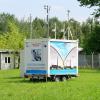Mobile lab is testing air quality in Warsaw
2014.11.21 14:23 - adminMobile environmental analyses lab developed in Świerk parked at the S2 express road – Al. Krakowska street junction for a few weeks of October, and at the Armii Krajowej Avenue (the Ruda housing estate) for a few weeks of November. Within framework of some research conducted by the Green Mazovia Association and the Światowid Ecology Association air quality in each of the points was precisely measured.
“It is estimated that in large cities car exhausts contribute as much as 80% to total air pollution” – said Dr. Jan Sernicki, NCBJ Interdisciplinary Applications of Physics Division Head– “Hydrocarbons belonging to the olefin group are the most active components of the exhaust fumes. Soot and carbon monoxide reacting with nitrogen oxides from the atmosphere are the main causes of smog, which is very harmful for people health”.
Capability to reliably evaluate air quality is more and more important for inhabitants of all agglomerations exposed to smog. Such evaluations are among major criteria taken into account in any analysis of the influence of each planned road development on the environment. To be able to reliably and accurately evaluate effectiveness of measures applied to protect the environment, air quality should be monitored continually for periods as long as several years after completion of the development.
“Mobile environmental analyses lab was built to be operational at various venues, including city streets.” – points out Professor Grzegorz Wrochna, NCBJ Director General – “It is also an example how outcomes of research may be applied in everyday life. Cooperation of our experts with the Green Mazovia Association and the Światowid Ecology Association may help to improve quality of life of the inhabitants: very precise determination of impact of the road traffic on human health at some specific point may be the first step to undertake actions aimed to minimize the impact negative aspects”.
Mobile environmental analyses lab is a dedicated air-conditioned container equipped with some state-of-the-art instruments that are capable to comprehensively analyse air quality. Advantages include a small footprint (slightly above 5.5 m2), lightweight compact housing, and capability of simple towing behind a passenger car. The lab may be used to have the air quality analysed in many distant places in a possibly short time.
Mobile environmental analyses lab on-board instruments include gauges commonly used by Voivodship Inspectorates for Environmental Protection, modern analysers, gravimetric dust samplers, setups for measurements of gaseous air contaminants (including nitrogen oxides, carbon monoxide, ozone), and a weather station equipped with a 10-meter high mast to record weather conditions prevailing at the venue during measurements. The lab may be used to comprehensively analyse fractions in particulate matter suspended in the air. As one of a few labs in the country it is capable to identify particles of diameters even as small as 20 nanometres, i.e. two thousand times smaller than human hair.
NCBJ has been for several years conducting R&D works on new methods to more effectively utilize weather data available in national databases and similar information available in real time to forecast concentration of particulate matter suspended in the air. Besides, some teams in Świerk (e.g. in the MANHAZ Excellence Centre) work on methods to simulate spread of various agents (including radioactive ones) throughout the environment using the large computational cluster deployed in Świerk Supercomputer Centre.
Mobile environmental analyses lab has been developed in NCBJ Interdisciplinary Applications of Physics Division within framework of the “Development of Ionizing Radiation-Based Technologies in NCBJ Świerk” project (a.k.a. 4LABy). The 39.7 million PLN worth project was co-financed by European Union from the Regional Development European Fund within framework of the “Regional Operational Programme for Masovian Voivodship 2007-2013”. Scope of the project included development/modernization/buying new equipment for four NCBJ labs (accelerating structures, plasma-ion beams, radiography, environmental measurements), as well as modernization of the Institute LAN.

















